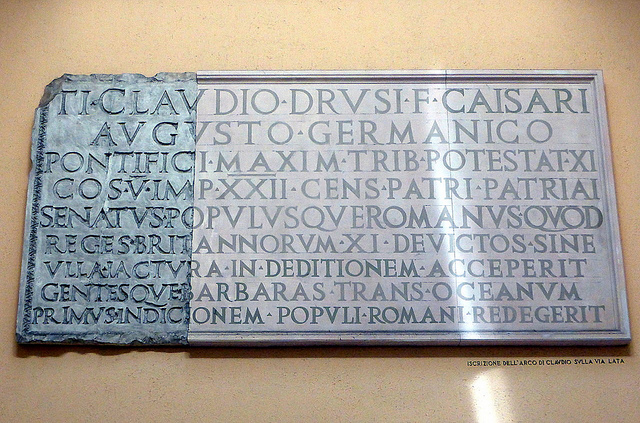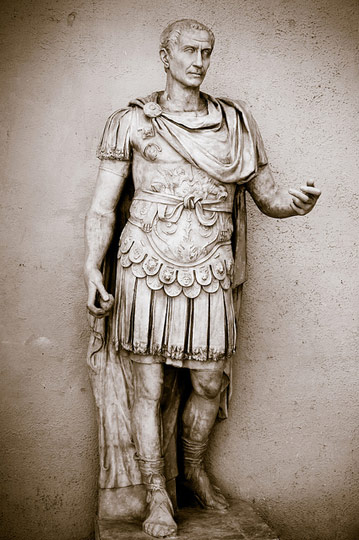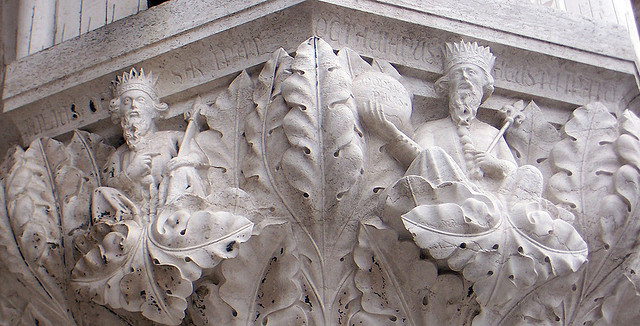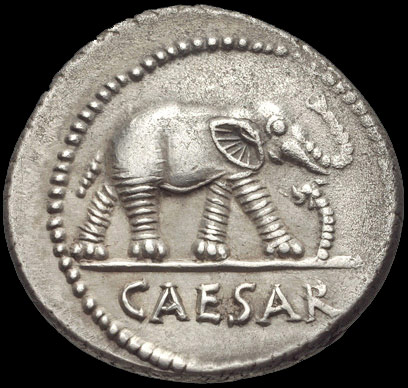Roman Nomenclature
(Tria Nomina, Roman naming conventions)
The Roman name usually consisted of three elements (tria nomina): a praenomen, a nomen (or nomen gentilicium) and a cognomen.
In their use, the Roman praenomen corresponds to our first name and the nomen to our surname, the latter being the only part of the name that is always inherited and that indicates our belonging to a family (note the French nom de famille for surname). However, as the word “surname” suggests, etymologically most family names stem from a nickname, or an identifiable trait or title, which is more similar to a cognomen. A surname can be a nickname (Bullock, meaning “young bull”), a place name (Ashley), a profession (Smith) or a honorific title, such as a title of nobility.
So, in our European tradition, the equivalent of the cognomen, which usually was a nickname, became the inherited part, the name that indicates our belonging to a specific family, while in ancient Rome the cognomen was usually specific to a person, but we will see that there were also exceptions to this rule.
The praenomen alone was only used with intimate friends and family. Otherwise it was always followed either by the cognomen (with acquaintances) or by the nomen and cognomen (in formal situations). In writing it was usually abbreviated rather than spelled out. The abbreviation could be the initial, or first three letters.

Reconstruction of the inscription from the Arch of Claudius in the Museo della Civilita Romana at EUR (the original is now in the Capitoline Museums, Roma). Notice the abbreviated name Ti(berio) Clau[dio Drusi f(ilio) Cae]sari / Augu[sto Germani]co / pontific[i maxim(o) (etc.) or ‘(For) Tiberius Claudius Caesar Augustus Germanicus, son of Drusus, pontifex maximus’ (etc.).
Let’s examine the following example of Roman nomenclature: Gaius Julius Caesar.
1. Praenomen
In our example, Gaius would be the praenomen or personal name, similar to our first name, but usually far less colorful and personal. Only about 100 praenomina were common in ancient Rome and the same ones were used over and over again from generation to generation, so that by 100 BC only about 20 common praenomina were still in use among patrician families. The two most common Roman praenomina Marcus and Gaius are derived from the god Mars, the legendary father of the twins Romulus and Remus, the founders of Rome,2 and Gaea, the Earth Goddess. Tiberius, another common Roman praenomen, comes from a sort of deity, the Father Tiber.
Other common praenomina are derived from circumstances of birth: Lucius (the light of day), Manius (morning), Posthumus (born after his father`s death), Gnaeus (“birthmark“), Spurius (possibly used for children born out of wedlock), Agrippa (“born feet first“) and Caeso („cut“, hence born by Caesarian section).
The so called “number names” possibly refer to the position in the sibship: Quintus, Sextus, Septimus, Octavius, Nonus, Decimus (fifth, sixth, seventh, eigth, nineth and tenth son respectively). However, as Roman nomenclature only uses numbers names from the fifth number up, some scholars, like the finnish philologist Olli Salomies, questions the fact that “number names“ were actually used to number sons in the family and utters the possibility that they designated the month of the child’s birth instead.
Some praenomina were exclusively used within the same family, for example Appius was used only by the Claudii and Tiberius only by the Claudii Nerones and the Aemilii families.
2. Nomen
If we continue with the same example, Julius would be the nomen or gentilicial name, which designated the person’s gens or clan. It was the most important element in the Roman naming system: it was the component of name that was inherited and also indicated the position of the gens in the state, its antiquity and sometimes its origin.
The original gentes were descended from the families who settled Rome, the Roman aristocracy. Well-known nomina include many of the familiar names of ancient Rome, such as Aemilius, Claudius, Cornelius, Julius, Pompeius, Antonius and Valerius. The nomen often ended in -ius, -eus or -us and were derived from a praenomen or a cognomen.
The majority of the non-Latin nomina gentilicia originally came from names of tribes. Nomen in the following endings, for example, indicated a non-Latin origin: Gallic origin (-acus), Etruscan (-na, -nius), Oscan (-idius), Umbrian or Picene origin (-ienus).
However, citizens whose aristocratic status was more recent, often had nomina derived from place names or nicknames. Barbatus (bearded), Crassus (fat), Calvus (bald), for example, were based on physical physical, but nomina could also refer to personality traits or qualities, Maximus (best), Brutus (brutish), or to professions Mallius (ironworker), Faber (carpenter), or have a symbolic meaning, Cicero (chickpea), Coepis (onion).
Tribes from Hispania favored names based on animals, such as Lupus (wolf), Corvinus (raven), Porcius (pig), Asinius (donkey). Nomina could also refer to historical figures or gods (Sulla, Romulus).
3. Cognomen
The Caesar of our example would be the cognomen or surname, which could be honorific or designate a branch within the gens or just be a nickname, in which case it was also known as an agnomen. The cognomen was not used officially until around the time of Sulla. Cognomina were sometimes inherited for the sake of convenience or to keep a honorable name within the family.
Occasionally, a fourth name was added to the tria nomina, for example in case of adoption all three names of the adoptive father were transmitted to the adoptee, and an adjectival form of the adoptee’s own nomen (formed by adding the suffix -anus) was usually added. Thus, when Gaius Octavius Thurinus was adopted by his great-uncle, Julius Caesar, his formal name became Gaius Julius Caesar Octavianus. Notice that this fourth name was sometimes used in a derogative or disrespectful way. In this original name, his cognomen Thurinus probably commemorated his father’s victory at Thurii.
Modern historians usually refer to him as Octavian when referring to the period before he officially gained the honorific Augustus (“the revered one”) which was added to his name in 27 BC. This title was also referred to as cognomina ex virtute and was usually a title of honor given to a great politician or a victorious general. In the latter case, the cognomina ex virtute often was a declination of the region conquered. P. Cornelius Scipio, for example, was subsequently known as P. Cornelius Scipio Africanus after he had defeated Hannibal.
4. What’s in the name Caesar?
To this day the etymology of the cognomen Caesar is unknown, but eventually it came to mean emperor (as is still evident in some foreign languages, for example in the Dutch keizer and German kaiser). Unlike what many think, Caesar was not given this cognomen because he was emperor, as the name had been in the Julius family for a very long time before he became emperor. Actually, it indicated to which branch of the Julius family Caesar belonged. It is only after that the name came to mean ’emperor’.
The original meaning of the name Caesar is subject to many hypothesis. The etymology favored by Pliny the Elder is that the name derives from the word caesum (‘cut out’), presumably because the first Caesar of the gens was cut from his mother’s womb. The word caesare would simply be a more ancient form of the verb caedere. However, Julius Caesar himself could not have been delivered by Caesarean section, as at that time this risky operation was only performed on dead or dying women, while Caesar’s mother is known to have lived many years after his birth. The operation, regulated by the Lex Casesarea (the “imperial law”, possibly originally “the law on autopsy”) was performed either in a last resort to save the baby’s life, or for religious reasons, so the infant could be buried separately from the mother.
Caesar himself favored a more heroic origin of his name. The name’s etymology would be related to the Punic word for “elephant” caesai, because the first bearer of the name had killed an elephant in a battle, possibly during the first Punic War. The suffix -ar was indeed highly unusual for a Latin name, which would confirm a non-Latin origin. On his first denarius (silver coin), Caesar displayed an elephant above the name CAESAR, as a claim for extraordinary political power in Rome, but probably also as an unmasked allusion to this etymology.
5. Women’s names
The Roman nomenclature for women was less defined and less complex, probably reflecting their subordinate role in Roman culture. Women often did not have a praenomen. Instead, they were named with the feminine form of the nomen (or, occasionally, the cognomen) that indicated her gens. Thus, women belonging to the gens Julius were named Julia, and women belonging to the Cornelius family were named Cornelia.
In public they could be identified by the genetive form of their father’s cognomen. If the women was married, her husband’s name was added to her full name. In other instances, the mother’s name was added. This custom reflects that fact that women had no independent status in Ancient Rome, they necessarily had a tutor, either the father in the case of an unmarried girl, or the husband, if she was married. Sometimes, a term in the form of an adjective indicating the order of birth (Maxima, Secunda, Tertia, Maior, Minor) or a diminutive (Livilla) was added to distinguish between sisters.
Some families, however, added a cognomen to the names of their female family members.
6. Slave Names
Slaves were named after their master. For example, Marcipuer and Marcipuella were derived from Marcus. When slaves were freed, they dropped the derivative of their master’s name and acquired the master’s praenomen and nomen. If a slave had been freed by a woman, he took her father’s praenomen and nomen plus his slave name
Sometimes they also added a latinized version of their original name (which was usually of foreign origin) to their full name.
The same occurred when a foreigner was granted Roman citizenship; he usually received the name of the emperor under whose rule the citizenship had been granted.
Originally written in August 2008, revised in October 2103 and May 2014.
Photo credits (top to bottom): detail Arch of Claudius by Mike Bishop; Palazzo Ducale detail by Sebastià Giralt; Gaius Julius Caesar by Colin Bewes.



